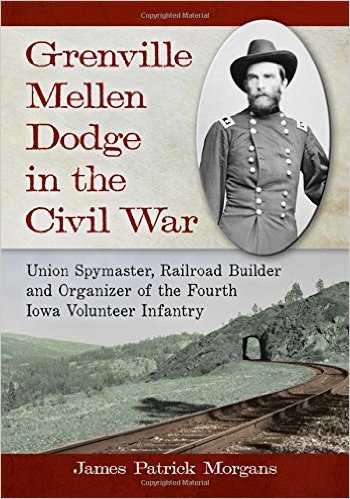Grenville Mellen Dodge in the Civil War: Union Spymaster, Railroad Builder, and Organizer of the Fourth Iowa Volunteer Infantry by James Patrick Morgans. McFarland, 2016. Paper, ISBN: 978-0786470693. $29.95.
 The title of this book sums up the remarkable Civil War career of Major General Grenville Dodge—a man who performed many important duties during the Civil War and is today all but forgotten. The late James Patrick Morgans has penned an interesting biography of a man who contributed much to Union victory in the western theatre.
The title of this book sums up the remarkable Civil War career of Major General Grenville Dodge—a man who performed many important duties during the Civil War and is today all but forgotten. The late James Patrick Morgans has penned an interesting biography of a man who contributed much to Union victory in the western theatre.
Unfortunately for the reader, the book immediately opens with Dodge’s wartime service. Even a few pages about his upbringing and military education, received at Norwich University in Vermont, would have been appreciated.
Shortly before the war began, Dodge surveyed the west for the Transcontinental Railroad and became an adviser to Lincoln about that effort. Early in the conflict, Dodge was in Washington and via telegraph accepted command of the Fourth Iowa Infantry. According to Morgans, Dodge “created an atmosphere of camaraderie, trust, courage, sacrifice, and unshakable loyalty among his recruits.”
Morgans does a good job of providing much needed background information regarding the socio-economic and political climate in Iowa and Missouri during the early days of the Civil War.
Dodge and his men were baptized by fire at Pea Ridge in early 1862. Neither the battle nor Dodge’s actions there are covered in much detail. After Pea Ridge, Dodge’s star literally began to rise with promotion to brigadier general. Assigned to engineer duties, he was successful at leading engineering projects and served under Grant at Vicksburg.
Dodge could also be considered one of the fathers of the military intelligence corps. Dodge organized a corps of spies and scouts who routinely slipped behind enemy lines to gather important information for Grant; importantly, they relied on information provided by women and runaway slaves.
Furthermore, Dodge used his prewar knowledge as a railroad builder to reconstruct and improve the Union supply lines. Dodge led a corps with great ability during the Atlanta Campaign, during which he was severely wounded and earned a promotion to major general. After participation in the campaign, Dodge became commander of the Department of Kansas. After the war, he briefly served in Congress and continued work on the Transcontinental Railroad, famously being a participant in the Golden Spike Ceremony at Promontory, Utah. Dodge returned to Iowa, where he was active in politics and veterans’ affairs, dying in 1916 at age 84.
In sum, this book presents a brief biography of one of the all but forgotten players who made victory for the Union possible. The book does suffer from a number of problems. While heavily illustrated, the lack of maps is especially distracting. Furthermore, the book attempts too much. Morgans continues to pursue the story of the Fourth Iowa after Dodge left the regiment, for example, providing almost a full regimental history. Finally, the book is largely researched from printed primary sources; few if any manuscript or other non-published works are cited. The extensive collection of Dodge material at Norwich University was not utilized at all for the project. Those interested in a biography of this amazing general officer might find a better source elsewhere.
Robert Grandchamp is the award winning author of nine books on American military history, including most recently A Connecticut Yankee at War. The recipient of an M.A. in American history from Rhode Island College, Grandchamp is an analyst with the federal government and resides in Jericho Center, Vermont.
